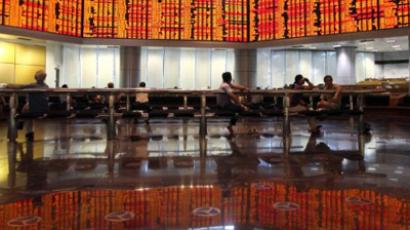Looking for a better outcome on the Russian equities market
With Russian equities taking a battering against a backdrop of global volatility Business RT spoke with Mlada Yegikyan, Equity Sales Manager at Otrkritie about the factors at driving investor concerns.
RT: Russia’s two main exchanges, the RTS and MICEX are both sharply lower. How would you describe the situation?MY:“Well the situation is clearly nothing short of a panic. We have seen somewhat panicky moods in the market last week, and luckily we have had 48 hours to digest the S&P downgrade over the weekend. We have seen a quite volatile session this morning – the market opened quite sharply down then recuperated part of its losses and clearly closing still lower. And especially it is visible across the blue chip universe, that are the easiest to get rid of. And what we observe at the moment in terms of client activity is we have seen hedge funds trying to get rid of the blue chip names, and the long institutions trying to pick up some of the value plays in the second tier universe.”RT: Is it a time to look for interesting bargain opportunities?MY:“There is clearly going to be a bounce of some sort in this market, because all markets do not move in the same direction at all times, they switch directions. My personal view would be that it is too early to talk about serious bargains. Even if we are to do a little bounce at some point tomorrow or next week it is still too early, things have to get worse before they get better, because there are still quite substantial problems on the table. The ECB problems, the Federal Reserve problems we will be looking at tomorrow. The Bernanke statement we will be looking forward to seeing whether there is any reaction to the European debt crisis, any reaction to the S&P downgrade, any potential hint towards a QE3 on the table. And all that is obviously adding risk to the markets and suggesting that there is still uncertainty to talk about a rally.”RT: Many investors now have sold their stocks. Where do they put their money? Gold is above $1700/oz. Is it too expensive?MY:“Gold by all technical means is somewhat oversold at the moment, however it can continue being oversold for the next several months, or even quarters to come in this environment. Ironically despite the S&P downgrade we have seen that the safe haven is still the US dollar which is still backed by U.S. Treasuries. In the short term there is no immediate solution to that. We have seen the US dollar selling of against some blue chip currencies, however strengthening ironically against emerging market currencies today, and this is going to be the case in the near term. We haven’t seen any forced selling of dramatic magnitude so far, in terms of future indicators, selling the treasuries, we don’t expect that to happen. Again, in the near term, the US is no closer to bankruptcy or default today versus what it was last Friday. And everyone clearly understands that. And there is no selling in treasuries because the S&P downgrade was just one downgrade out of four nationally recognized ratings agencies. Therefore according to the SEC regulation, money market funds are not forced to sell based on this technical downgrade.”RT: So the position of the US currency has not really been undermined by this downgrade?MY: “Exactly, I would completely agree with that. It is just that there is no alternative in the medium term. The Euro seems to be somewhat more expensive versus where it should be trading at the moment, by logical means, however, there are other technical indicators that are basically would require some time for the currencies to adjust to where they should be trading following the catalysts that we have seen so far. For the US dollar, perhaps in the medium term, there should be some depreciation, but in the short term we don’t expect any significant selloff. The ECB is more at risk at the moment, the euro currency is more at risk at the moment in our view, and the solvency of the ECB has been the question for many of the investors, given the safety fund that the European Union has close to 500 billion Euros against a potential troubled Italian debt of near 2 trillion Euros, and given that people are asking for potential lenders of last resort, that could be the Federal Reserve . But still the US Treasuries are still seen as the ultimate final lender in this market environment at least. And it is printing money for as long as the market requires and the only downside risk from this printing money is clearly potentially inflationary pressure on the market.” RT: How long to you think it will take this turbulence to settle down?MY:“I think we will have to see some positive indicators for the growth coming out of the United States in the second half year to be confident that we are not in a double dip recession. Historically the US GDP falling below 2% means for 9 out of 10 times that the US economy will go into recession. Hopefully this is not the right indicator for us at this point, because this is somewhat of a special situation put together. So clearly we have seen some indicators of sluggish growth so far in the second quarter and its sluggish outside of the one offs that we have seen, such as the Japanese earthquake and the spike in the oil price. We need to see some growth in employment we need to see some reaction from the Federal Reserve, that is why tomorrows Bernanke statement is quite important. Because potential indication of QE3 of some monetary intervention is clearly needed here. In this environment, given that the fiscal intervention is out of the question at the moment. Following the US debt ceiling resolution whereby the US government pledged not to increase their budget, pledged to cut their spending somewhat and to take their debt under control. Therefore in this environment when the government stimulus is impossible the monetary stimulus is basically, the Fed is ultimately the hope that we have, so I guess the potential monetary reaction by the Fed and some indicators that growth is still there, in the second quarter is going to help the market to recuperate somewhat.”














